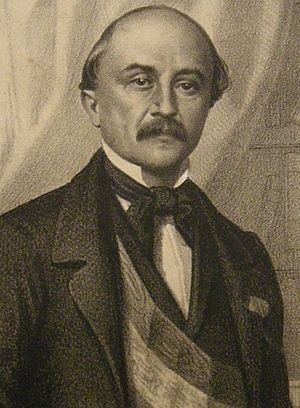Luigi Carlo Farini facts for kids
Quick facts for kids
Luigi Carlo Farini
|
|
|---|---|
 |
|
| Prime Minister of Italy | |
| In office 8 December 1862 – 24 March 1863 |
|
| Monarch | Victor Emmanuel II |
| Preceded by | Urbano Rattazzi |
| Succeeded by | Marco Minghetti |
| Personal details | |
| Born | 22 October 1812 Russi, Kingdom of Italy |
| Died | 1 August 1866 (aged 53) Quarto dei Mille near Genoa, Kingdom of Italy |
| Political party | Historical Right |
Luigi Carlo Farini (born October 22, 1812 – died August 1, 1866) was an important Italian doctor, politician, and historian. He played a big part in making Italy a united country.
Contents
Luigi Farini's Early Life and Career
Luigi Carlo Farini was born in a town called Russi. This town is now part of the province of Ravenna in Italy.
He studied at the University of Bologna. During his studies, he joined the Carbonari, a secret group that wanted to change the government in 1831. After university, he worked as a doctor in Russi and Ravenna. He became well-known for his medical skills.
Leaving Italy and Returning Home
In 1843, Farini's political ideas caused problems with the police. He was forced to leave the Papal States, which were areas ruled by the Pope. He lived in Florence and Paris for a while. He even traveled around Europe as a personal doctor for Prince Jérôme Bonaparte.
When Pope Pius IX became Pope, he seemed to have more modern ideas. Farini returned to Italy and became a secretary in the government in March 1848.
Farini and the Pope
Farini's time in government was short. Like many other Italian liberals, he disagreed with Pope Pius IX. The Pope decided not to let his soldiers fight against Austria. Because of this, Farini and other ministers resigned on April 29.
To try and fix things, the Pope sent Farini to Charles Albert of Sardinia, who was the King of Sardinia. Farini was to hand over the Pope's soldiers to the King.
Becoming a Member of Parliament
Farini was elected as a member of parliament for Faenza. He worked again as a secretary in the government. Later, he became the head of the public health department.
When the Pope left Rome in 1849, a republic was declared. Farini resigned from his job. He briefly returned when the Pope came back to Rome with French help. But when the Pope's government became very strict, Farini went into exile again.
Working for Italian Unity
Farini moved to Turin. There, he became convinced that only the House of Savoy (the royal family of Sardinia) could unite Italy. He wrote about his ideas in newspapers like Il Risorgimento. He also wrote an important history book called Lo Stato Romano dal 1815 al 1850.
Joining the Government in Sardinia
In 1851, Farini became the Minister of Public Instruction in the government led by Massimo Taparelli, marquis d'Azeglio. He held this job until May 1852.
As a member of parliament and a journalist, Farini strongly supported Camillo Benso, Count of Cavour, another key figure in Italian unification. Farini was a big supporter of Sardinia joining the Crimean War. Some even say he was the first to suggest it.
Speaking Out for Italy
In 1856 and 1857, Farini wrote letters to William Ewart Gladstone, a British politician. These letters were about Italian issues and caused a lot of discussion. He continued to share his views in Italian newspapers.
Leading Central Italy
When the war of 1859 began, the Duke of Modena was removed from power. Farini was sent to Modena as a representative from Piedmont. Even after the war ended with the peace of Villafranca, Farini stayed. He was determined to see central Italy join Sardinia/Piedmont.
He became a citizen of Modena and took charge of the state. He made an agreement with other areas like Parma, Romagna, and Tuscany. He also asked General Fanti to create an army for this group of central Italian states.
Joining Piedmont and Later Life
The people of central Italy voted to join Piedmont. After some disagreements with Napoléon III, Farini returned to Turin. The King gave him a special award. Cavour then made him Minister of the Interior in June 1860. Later, he became the viceroy of Naples. However, he soon resigned due to poor health.
Cavour died in 1861. The next year, Farini became Prime Minister, taking over from Urbano Rattazzi. He tried to continue Cavour's plans for Italy. But working so hard made him very ill. He had to resign on March 24, 1863. He later passed away in poverty at Quarto dei Mille near Genoa.
Farini was first buried in Turin, but in 1878, his body was moved to his hometown of Russi. His son, Domenico Farini, also had a successful political career. He was the President of the Chamber of Deputies three times and also President of the Senate.
See also
 In Spanish: Luigi Carlo Farini para niños
In Spanish: Luigi Carlo Farini para niños

